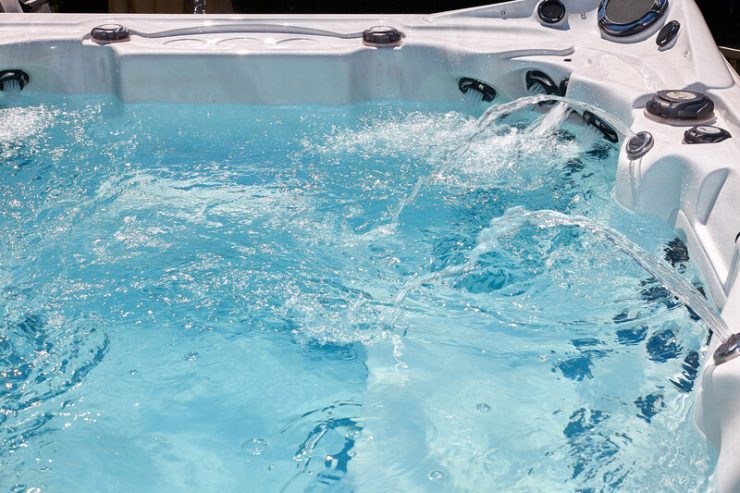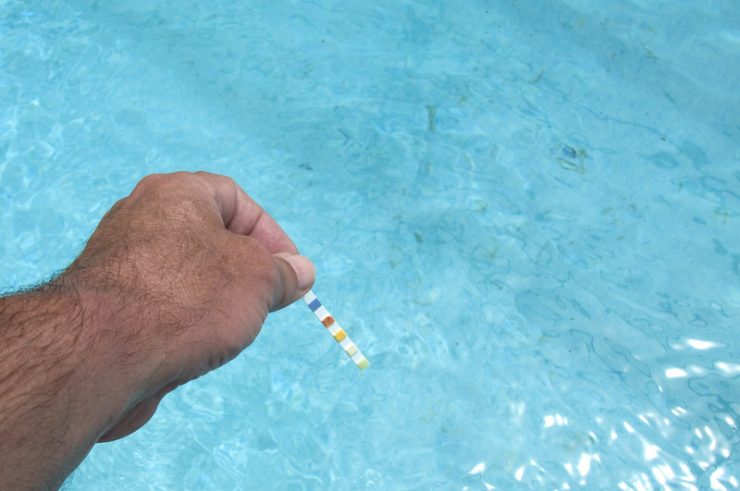Discovering a high pH level in your hot tub might make you dread the thought of adding more harsh chemicals to adjust it. Maybe you’re curious if there is a natural pH decreaser alternative. Maybe something like a natural acid like vinegar will work.
So, is it possible to lower pH with vinegar? And, if so, how do you do it?
It is possible to lower your hot tub’s pH level with vinegar. Vinegar contains acetic acid, and when added to water, reduces the water’s pH. All you need to do is to calculate how much you need to reduce the pH and then add 4 cups of vinegar each time until you rebalance pH levels.
Before we dive into the steps of how to apply vinegar to your hot tub, let’s have a look at the most popular options for pH decreasers for your hot tub.

Article Contents
What Can You Use to Reduce Hot Tub pH?
You can use several pH-reducing agents, with muriatic acid and sodium bisulfate being the most common. But, you can also use hydrochloric acid and vinegar too.
There are pros and cons when choosing any of the above chemicals. Let’s quickly look at each so you know where you stand.
Muriatic Acid
Muriatic acid is the most common pH reducer in hot tubs due to its low cost. And it comes in liquid form. However, it is highly corrosive, so take extra care and wear protective clothing when handling it.
Muriatic acid works quickly to lower pH. And it also helps clean stains, kill mold and algae, and remove calcium build-up. So, if you’re curious about using this acid as your primary pH decreaser, why not have a look at our guide: Can I Add Muriatic Acid All at Once? | How to Safely Add?
Sodium Bisulfate
Sodium bisulfate is safer to use than muriatic acid. But, it is more expensive than its more corrosive counterpart. Sodium bisulfate comes as a dry acid in granular form.
This acid is also good at lowering pH levels in your hot tub. But, it’s crucial to handle it with care. Dealing with fine chemicals (like sodium bisulfate) can make it easier for the wind to whip some into your eyes or open mouth.
Hydrochloric Acid
Hydrochloric acid is a purer, more concentrated version of muriatic acid. Whereas muriatic acid is yellow (from its impurities), hydrochloric acid is clear.
Because of its incredible strength, you’re more likely to find hydrochloric acid in laboratory settings rather than in a pool store. (For reference, muriatic acid is a diluted version (usually 20%) of hydrochloric acid.)
Although it can be a pH-reducer option, the risks of mishandling far outweigh the benefit of using pure hydrochloric acid.
Vinegar
Vinegar is a natural way to reduce pH. A diluted form of acetic acid, it is the safest pH-reducing chemical in this group. Mishandling vinegar would unlikely result in injury to you or damage to your hot tub.
When you dilute the vinegar with water, its acidity decreases. And this decrease helps neutralizes the hot tub pH. However, its strength is much lower than the other acids. So you’ll need a much higher dose to achieve the same result.
Related Reading: How Much Muriatic Acid To Lower Pool pH & Alkalinity
Natural Ways to Reduce pH in Hot Tubs
The best natural way to reduce pH in your hot tub is to use sodium bisulfate or vinegar.
Sodium Bisulfate
It may be surprising to read that sodium bisulfate is natural, according to Consumer Brands Association (formerly Grocery Manufacturers Association). This is because it derives from natural minerals.
However, commercially sold sodium bisulfate is produced from sulfuric acid (synthesized from elemental sulfur).
Vinegar
Vinegar is an umbrella term for products that contain acetic acid. Naturally occurring bacteria (acetobacters) interact with oxygen in fermented liquid to create acetic acid.
It is possible to get natural vinegar and synthetic vinegar.
Natural vinegar comes from organic sources such as apples or barley. Whereas synthetic vinegar originates from fossil fuels and has a greater carbon footprint.
The main difference between the two is the acetic acid concentration; natural being <10% vs. synthetic being <80%. Therefore, synthetic vinegar tends to feature in many industrial cleaning products.
Is Vinegar Effective in Lowering Hot Tub pH?
Vinegar is effective in lowering hot tub pH. However, to achieve the same effect as commercial pH reducers sold in hot tub supplies stores, you’ll need a much higher dosage of vinegar.
Unlike other pH decreasing agents, vinegar isn’t specifically made to lower pH so it will take larger amounts to achieve the same result.
Muriatic acid and sodium bisulfate may be more corrosive than vinegar. But you get better results with these acids as you only need small dosages. And when handled and used correctly, they are both safe.
Why Use Vinegar to Lower Hot Tub pH
There are many reasons why you might use vinegar to lower your hot tub’s pH. These include ease of storage, safer to handle, ease of access, and because it’s natural.
Ease of Storage
There aren’t any special considerations to factor in when storing vinegar. Though, to get the most of it, keep it out of direct sunlight and store it in a cool, dry area. With acids like muriatic acid, accidental contact with your hot tub (in concentrated form) can create lasting damage to the surface or external components of your hot tub. Or your skin.
Safer to Handle
Acetic acid (vinegar) is much safer to handle than other pH-reducing acids. However, it still is an acid and can have corrosive impacts even in its weakened state. Handle it with care and take protective measures before and after use.
Ease of Access
Vinegar is far easier to find than the other listed pH decreases. You can find vinegar in most grocery stores. And, having vinegar on hand in your house is more likely than the others. Plus, vinegar is much cheaper than the likes of muriatic acid. (However, the differences in dosages will outweigh the long-term cost.)
Natural
For many people, wanting their luxury without sacrificing their environmental beliefs is normal. Avoiding artificial products isn’t always possible in life. So, being able to choose a natural pH reducer with a lesser carbon footprint impact is the perfect solution for many environmentally-conscious hot tub owners.
pH Decreaser Vs. Vinegar
Although the cheaper price tag of vinegar is attractive, there’s a reason for that. Specifically designed pH reducers are magnitudes more acidic and effective than vinegar. Therefore, you need much more vinegar to successfully decrease your hot tub’s pH.
Depending on many factors such as size and concentration, you can get vinegar around 4x cheaper than the industrially designed pH decreasers (pH Down products).
For example, to lower pH with vinegar, many recommend using a dosage of 4 cups (946 ml) to start with. Whereas according to this pool calculator, you roughly need 1 cup, 4 tsp (255 ml) of muriatic acid to normalize pH. Or 3/4 cup, 2 tsp (204 ml) of sodium bisulfate.
As you can see, you need roughly 4x more vinegar to rebalance pH than sodium bisulfate or muriatic acid.
Out of these three acids, sodium bisulfate is the best option. It’s easy to store (as it’s dry) and balances cost with dosing compared to muriatic acid. Muriatic acid then should be your second choice if you’re looking for cost-effective pH decreasers.
With vinegar, some hot tub owners notice that there is sometimes an odor in their hot tubs after use. Plus, there is the potential for the vinegar to interact with dissolved solids within the water, creating scaling.
How Much Vinegar Do You Need to Lower Hot Tub pH?
Most hot tub experts advise 4-cup measurements when using vinegar to lower pH. It can be a case of trial and error to find the exact amount. However, start with 4 cups of vinegar and retest.
Regularly testing your hot tub’s water chemistry during the vinegar application process is crucial to getting the dosage right. Things like the vinegar type you use and its acetic acid content will factor heavily into how well it lowers pH.

How to Use Vinegar to Lower Hot Tub pH (Step by Step)
Lowering your hot tub’s pH with vinegar is an easy process. Simply follow the steps below to rebalance pH.
To lower hot tub pH using vinegar:
1. Test the Water
Firstly, test your hot tub’s water chemistry using pool chemistry test strips. This will give you a baseline measurement. And allow you to calculate how much you need to reduce the pH. This is a test strips kit we can recommend:
- Suit pools and spas
- Tests 7 things including chlorine, bromine, pH, cyanuric acid
- Quick & easy to use
2. Measure the Vinegar
Measure out 4 cups (946 ml) of your chosen vinegar (white distilled or apple cider work best).
3. Add the Vinegar to the Hot Tub
Add it directly to the hot tub water.
Make sure you keep the pump running after application so the vinegar can circulate fully.
4. Run the Pump
Leave the pump running for at least 4-6 hours before retesting the hot tub.
5. Retest and Repeat if Necessary
Retest the pH level of the water. If it’s still high, you can repeat the process using the same measurements.

Final Thoughts
Whether you’re looking to cut down on using artificial, toxic chemicals. Or maybe you’re curious if vinegar is a cheaper option to lower pH, be confident that you can use vinegar in your spa or hot tub.
Although it is the best natural option, it will take you many more doses than the likes of muriatic acid to decrease your pH level.
It’s good to know vinegar is there as an option, particularly if you find you’re out of your usual pH reducer. But, using it as your primary pH reducer isn’t as wallet-friendly or effective as the other acids listed here.
Whether you’re new to hot tubs or want a refresher on the importance of water chemistry, check out our guide: Do Hot Tubs Need Stabilizer? | How to Use Stabilizer
Related Reading:
How to Reduce pH Level in a Saltwater Swimming Pool
Can You Fill a Hot Tub or Spa with Well Water?
How to Raise Alkalinity in Hot Tub (Alkalinity is Low)
Soda Ash vs. Baking Soda for Hot Tub: Which is Better?
Chlorine Vs Bromine for Hot Tubs (Which is Better?)
Neutralize And Clean Up A Muriatic Acid Spill (Around A Pool)
Does Adding Chlorine Change Pool pH Level?
How to Lower pH in Hot Tub (pH is Too High)
How to Fix a Slimy Feeling Hot Tub (Clear Biofilm)


